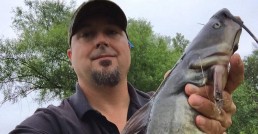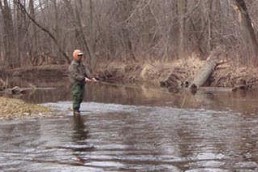Most Important Item in Fishing: Leader and Hook
SHARE THIS POST
When you boil down fishing it comes down to that split second when the fish has to recognize what you have. They either see it as food or not.
What we struggle with in terms of delivering a quality presentation to the fish is simple to fix. Take a look at what you have been putting in front of the fish and simply change the last 12 inches— the last portion of line called the leader. The leader is the critical line that connects the hook to your bait and the part that fish see, feel and use.
Mechanically speaking, a quality leader is one that is the most flexible and resists the least when fish strike. Part of the “mechanics” is that the fish tries to vacuum in the bait. And, if your leader is stiff, thick, hard and too heavy, your food won’t go in their mouths as easy, if it goes in at all. In nature, when the fish vacuums their food, it easily goes in. Sadly, for us, when fish are feeding on an average day they have their vacuum set to low power. You see their natural food comes up off the dirt, gravel or weeds with very little vacuum power. So, the reason you don’t catch fish is your leader of 4- or 6-pound line is very stiff and inflexible, especially for instance when compared to 2- or 3-pound leader line. We’ve also learned that since there are only 6 or 12 inches of the stuff in your whole setup, it would then be best to spend the most attention and spend a little extra money to get really nice leader line. Do this and you can improve your catch-rates Why? Because these can actually vacuum in the thinner line easier due to their flexibility.
You need to be flexible too, and change the way you fish. Use ice fishing line on your leader line and make your own hook lines, which will get you so many more bites. I also use the 2-pound-test line when I am not near weed snags or heavy structure. On open water, I can land a 13-pound fish on the 2-pound line.
Are you enjoying this post?
You can be among the first to get the latest info on where to go, what to use and how to use it!
The other parts of our more “flexible” leader rig are the hook small swivel between your main line and your new leader. The steel swivel will take the line twist out of your live-bait rig and it also offers a nice connecting point. When I use spinning gear—usually 9- to 12-foot spinning rod of medium light action—I always use a swivel. I also use a size 400 or 4000 reel. This is the ultimate casting setup for long casts from shore or boat.
The last item is also important: the hook. I never use wire hooks unless it is an absolute disaster-emergency. Instead, I choose steel hooks. There are good ones on the market and I use these ranging from size 10 to 16 for nearly every species. For many species steel is necessary, and it’s lighter and stronger than the wire and much more sharp. The hook is stronger too, and I get better hook-sets. And these sneak by the fish’s vision and they hold the bait longer in their mouths using the smaller steel hooks. With larger hooks, they eject the hook faster, giving us less time to set the hook.
If you have never used small hooks, you need to. These have helped me catch over 3,000 fish in 2016, and I worked on the water a lot helping others. Someday I will shoot for 10,000 fish in a season and they will all be caught with the above information, and the tiny hooks. The small hooks also do less damage to my baits. A key factor in my baits looking better than yours is because my small hooks don’t murder it instantly.
Because you are making the switch to better catching, you will need two tools. First, a couple of hook removers, a tool that gets deep hooks out every time. The second tool is the Hook Ninja knot-snelling tool. It ties a batch of leaders and hooks. With this, you can tie the tiniest little hooks, ones we know are the best for catching fish.
MWO
SHARE THIS POST
Did you enjoy this post?
You can be among the first to get the latest info on where to go, what to use and how to use it!
Johnny Wilkins
MidWest Outdoors works with more than 200 outdoor experts each year, who contribute articles based on their areas of expertise. MidWest Outdoors magazine offers more fishing and hunting articles than any other publication!



